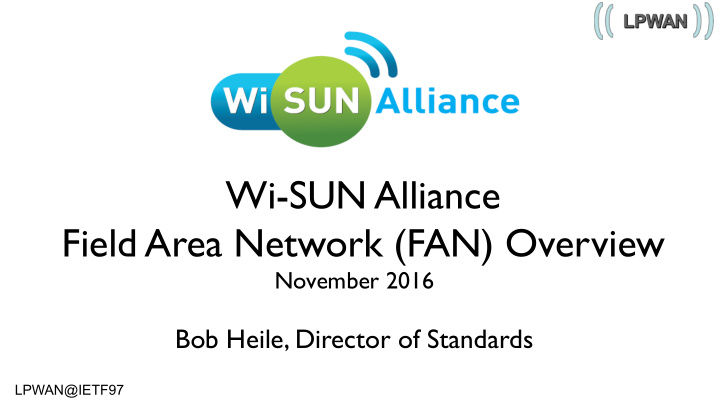



Wi-SUN Alliance Field Area Network (FAN) Overview November 2016 Bob Heile, Director of Standards LPWAN@IETF97
Wi-SUN Alliance FAN LPWAN@IETF97 2
FAN Use Cases Network Operations Center Public or Private WAN Backhaul WAN (Cellular, WiMAX, Fiber/Ethernet) IEEE 802.15.4g/e RF Mesh IEEE 802.15.4g/e RF Mesh IEEE 802.15.4g/e RF Mesh FAN Direct AMI Metering Transformer Distribution EV Charging Distributed SCADA Outdoor Gas / Water Load Monitoring Automation Infrastructure Generation Protection and Lighting Meters LPWAN@IETF97 3 Control Control Network
Wi-SUN FAN Communications Overview Application Application Application Service Layer Application layer HTTP CoAP - - - - - - - - - - - - - - TCP UDP Transport layer - - - - - - - - - - - - - - IPv6 Routing: RPL Proprietary Network layer 802.1x / 802.15.9 EAP-TLS Adaptation Layer - - - - - - - - - - - - - 6LoWPA - N Cellular Data link layer IEEE 802.11 IEEE 802.16 IEEE 802.15.4 (Wi-Fi) (WiMax) - - - - - - - - - - - - - (g/e) - PHY layer LPWAN@IETF97 4
Wi-SUN FAN Summary • Open standards based on IEEE802, IETF, TIA, ETSI • Architecture is an IPv6 frequency hopping wireless mesh network with enterprise level security • Simple infrastructure which is low cost, low complexity • Superior network robustness, reliability, and resilience to interference, due to high redundancy and frequency hopping • Excellent scalability, long range, and energy friendliness • Supports multiple Global license-exempt sub GHz bands • Multi-vendor interoperability • Very low power modes in development permitting long term battery operation of network nodes. LPWAN@IETF97 5
FAN Stack Overview OSI Layer Wi-SUN FAN IPv6 protocol suite TCP/UDP • Application 6LoWPAN Adaptation + Header Compression • Application Layer Presentation DHCPv6 for IP address management. • (Out of Scope) Session Routing using RPL. • ICMPv6. • Unicast and Multicast forwarding. • Security Transport UDP / TCP MAC based on IEEE 802.15.4e + IE extensions 802.1X, IPv6 / ICMPv6 / RPL / Frequency hopping • 802.11i, Network 6LoWPAN EAP-TLS Discovery and Join • LLC Sub-Layer Protocol Dispatch (IEEE 802.15.9) • Several Frame Exchange patterns • L2 MESH ETSI- Optional Mesh Under routing (ANSI 4957.210). • TS-102- Data Link PHY based on 802.15.4g 887-2 MAC Sub-Layer Various data rates and regions • Security 802.1X/EAP-TLS/PKI Authentication. • PHY Physical Layer 802.11i Group Key Management • FAN Optional ETSI-TS-102-887-2 Node 2 Node Key Management • Device Supports a variety of IP based app protocols : DLMS/COSEM, ANSI C12.22, DNP3, IEC 60870-5-104, ModBus TCP , CoAP based management protocols. LPWAN@IETF97 6
Protocol layers • Physical layer – FSK modula3on – Data rates from 50 kbps to 300 kbps – Node to node range up to several kilometres where regula3ons permit – Op3onal forward error correc3on for beCer link margin – Specified for Australia, Europe, India, Japan, Korea, North/South America, South East Asia LPWAN@IETF97 7
Protocol layers • Data link layer – Frame supports full IP payloads – 4 octet FCS for good error detec3on – De-centralised frequency hopping where permiCed (ANSI 4957.200) – Channel blacklis3ng for interference mi3ga3on – Link layer encryp3on / integrity checking for privacy & message verifica3on – Op3onal L2 mul3-hop layer (ANSI 4957.210) LPWAN@IETF97 8
Protocol layers – Adaptation Layer : 6LoWPAN • IPv6 header compression • UDP header compression • Fragmentation • Neighbour discovery • Routing support – Network layer • IPv6 • DHCPv6 address management LPWAN@IETF97 9
Protocol layers – Routing • ROLL/RPL – Security • L2 Integrity Check and Encryption • IEEE 802.1x over IEEE 802.15.4 ( IEEE802.15.9) • Uses Certificates for Mutual Authentication LPWAN@IETF97 10
FAN Profile - General Comments • The Alliance feels there is significant value to this LPWAN effort in IETF and strongly supports its objec3ves. • The FAN spec was developed to serve the LPWAN space among others. • Already included are many of the needed networking elements as a result of the longstanding working rela3onships between IETF and IEEE802. LPWAN@IETF97 11
FAN Profile - General Comments • Some of the things the Alliance hopes to accomplish through its participation in the LP-WAN WG are: – awareness (if changes are needed in the FAN spec), – help ensure consistency of approach, – share relevant experience, and – address co-existence issues & potential interoperability, since these solutions will be used in the same markets in complementary ways. • Because it is IP based, the Wi-SUN FAN already interconnects to Ethernet and WiFi through routers • Useful if the same can be accomplished with other approaches LPWAN@IETF97 12
Things We Would Like to See • Wi-SUN FAN and HAN profiles both use 6lowpan, primarily for header compression. • Full IP frames supported, but header compression is useful for op3mizing bandwidth. • Very useful to include UDP and CoAP compression methods also • Not all nodes on a Wi-SUN FAN are necessarily rou3ng, line powered nodes • Op3mized compression for baCery powered leaf nodes would help extend baCery life. LPWAN@IETF97 13
Thank you for your kind attention http://www.wi-sun.org LPWAN@IETF97 14
Recommend
More recommend